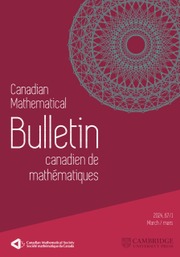No CrossRef data available.
Article contents
Infinitely repeated partitions of Liouville numbers
Published online by Cambridge University Press: 06 August 2025
Abstract
We show that the set of Liouville numbers has a rich set-theoretic structure: it can be partitioned in an explicit way into an uncountable collection of subsets, each of which is dense in the real line. Furthermore, each of these partitioning subsets can be similarly partitioned, and the process can be repeated indefinitely.
MSC classification
Primary:
11B05: Density, gaps, topology
Information
- Type
- Article
- Information
- Copyright
- © The Author(s), 2025. Published by Cambridge University Press on behalf of Canadian Mathematical Society
References
Bluhm, C.,
Liouville numbers, Rajchman measures, and small Cantor sets
. Proc. Amer. Math. Soc. 128(2000), no. 9, 2637–2640.Google Scholar
Chalebgwa, T. P. and Morris, S. A.,
A continuous homomorphism of a thin set onto a fat set
. Bull. Austral. Math. Soc. 106(2022), no. 1, 500–503. https://doi.org/10.1017/S00004972722000296.Google Scholar
Chalebgwa, T. P. and Morris, S. A.,
Erdos-Liouville sets
. Bull. Austral. Math. Soc. 107(2023), no. 2, 284–289. https://doi.org/10.1017/S0004972722001009.Google Scholar
Chalebgwa, T. P. and Morris, S. A.,
Topology meets number theory
. Amer Math. Month. 131(2024), no. 8, 669–689.Google Scholar
Chaves, A. P., Marques, D., and Trojovsky, P.,
On the arithmetic behavior of Liouville numbers under rational maps
. Bull Braz Math Soc, New Series 52(2021), 803–813.Google Scholar
Erdös, P.,
Representations of real numbers as sums and products of Liouville umbers
. Michigan Math. J. 9(1962), no. 1, 59–60.Google Scholar
Gelfond, A. O., Transcendental and algebraic numbers, translated from Russian by Leo F. Boron, Dover Publications, Inc., Mineola, NY, 1960–1988.Google Scholar
Grabowski, A. and Korniłowicz, A.,
Introduction to Liouville numbers
. Formal. Math. 25(2017), no. 1, 39–48. https://doi.org/10.1515/forma-2017-0003.Google Scholar
Grant, K.,
The converse of Liouville’s theorem
. Amer. Math. Month. 98(1991), no. 4, 354.Google Scholar
Ho, C. and Zimmerman, S.,
On certain dense, uncountable subsets of the real line
. Amer. Math. Month. 125(2018), no. 4, 339–346; https://doi.org/10.1080/00029890.2018.1420334.Google Scholar
Liouville, J.,
Memoires et communications
. Comptes rendus de l’Académie des Sci. 18(1844), 883–885.Google Scholar
Liouville, J.,
Sur des classes très-étendues de quantitiés dont la valeur n’est ni algebrique, ni même réductible à des irrationalles algébriques
. J. Math. Pures et App. 16(1851), 133–142.Google Scholar
Zimmerman, S. and Ho, C.,
Partitioning the real line into an uncountable collection of everywhere uncountably dense sets
. Amer Math. Month. 126(2019), no. 9, 825–834; https://doi.org/10.1080/00029890.2019.1640529.Google Scholar
Zimmerman, S. and Ho, C.,
Partitioning the rationals and other subsets of the real numbers
. Math Newslett., Ranmanujan Math. Soc. To appear, (2025).Google Scholar


